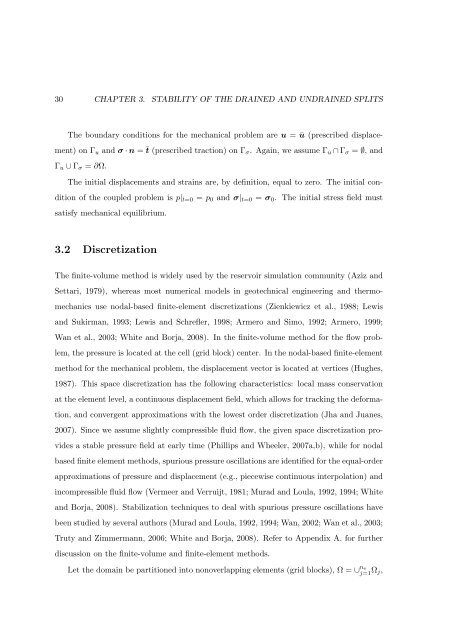Sequential Methods for Coupled Geomechanics and Multiphase Flow
Sequential Methods for Coupled Geomechanics and Multiphase Flow
Sequential Methods for Coupled Geomechanics and Multiphase Flow
You also want an ePaper? Increase the reach of your titles
YUMPU automatically turns print PDFs into web optimized ePapers that Google loves.
30 CHAPTER 3. STABILITY OF THE DRAINED AND UNDRAINED SPLITS<br />
The boundary conditions <strong>for</strong> the mechanical problem are u = ū (prescribed displace-<br />
ment) on Γu <strong>and</strong> σ · n = ¯t (prescribed traction) on Γσ. Again, we assume Γu ∩ Γσ = ∅, <strong>and</strong><br />
Γu ∪ Γσ = ∂Ω.<br />
The initial displacements <strong>and</strong> strains are, by definition, equal to zero. The initial con-<br />
dition of the coupled problem is p|t=0 = p0 <strong>and</strong> σ|t=0 = σ0. The initial stress field must<br />
satisfy mechanical equilibrium.<br />
3.2 Discretization<br />
The finite-volume method is widely used by the reservoir simulation community (Aziz <strong>and</strong><br />
Settari, 1979), whereas most numerical models in geotechnical engineering <strong>and</strong> thermo-<br />
mechanics use nodal-based finite-element discretizations (Zienkiewicz et al., 1988; Lewis<br />
<strong>and</strong> Sukirman, 1993; Lewis <strong>and</strong> Schrefler, 1998; Armero <strong>and</strong> Simo, 1992; Armero, 1999;<br />
Wan et al., 2003; White <strong>and</strong> Borja, 2008). In the finite-volume method <strong>for</strong> the flow prob-<br />
lem, the pressure is located at the cell (grid block) center. In the nodal-based finite-element<br />
method <strong>for</strong> the mechanical problem, the displacement vector is located at vertices (Hughes,<br />
1987). This space discretization has the following characteristics: local mass conservation<br />
at the element level, a continuous displacement field, which allows <strong>for</strong> tracking the de<strong>for</strong>ma-<br />
tion, <strong>and</strong> convergent approximations with the lowest order discretization (Jha <strong>and</strong> Juanes,<br />
2007). Since we assume slightly compressible fluid flow, the given space discretization pro-<br />
vides a stable pressure field at early time (Phillips <strong>and</strong> Wheeler, 2007a,b), while <strong>for</strong> nodal<br />
based finite element methods, spurious pressure oscillations are identified <strong>for</strong> the equal-order<br />
approximations of pressure <strong>and</strong> displacement (e.g., piecewise continuous interpolation) <strong>and</strong><br />
incompressible fluid flow (Vermeer <strong>and</strong> Verruijt, 1981; Murad <strong>and</strong> Loula, 1992, 1994; White<br />
<strong>and</strong> Borja, 2008). Stabilization techniques to deal with spurious pressure oscillations have<br />
been studied by several authors (Murad <strong>and</strong> Loula, 1992, 1994; Wan, 2002; Wan et al., 2003;<br />
Truty <strong>and</strong> Zimmermann, 2006; White <strong>and</strong> Borja, 2008). Refer to Appendix A. <strong>for</strong> further<br />
discussion on the finite-volume <strong>and</strong> finite-element methods.<br />
Let the domain be partitioned into nonoverlapping elements (grid blocks), Ω = ∪ ne<br />
j=1 Ωj,
















